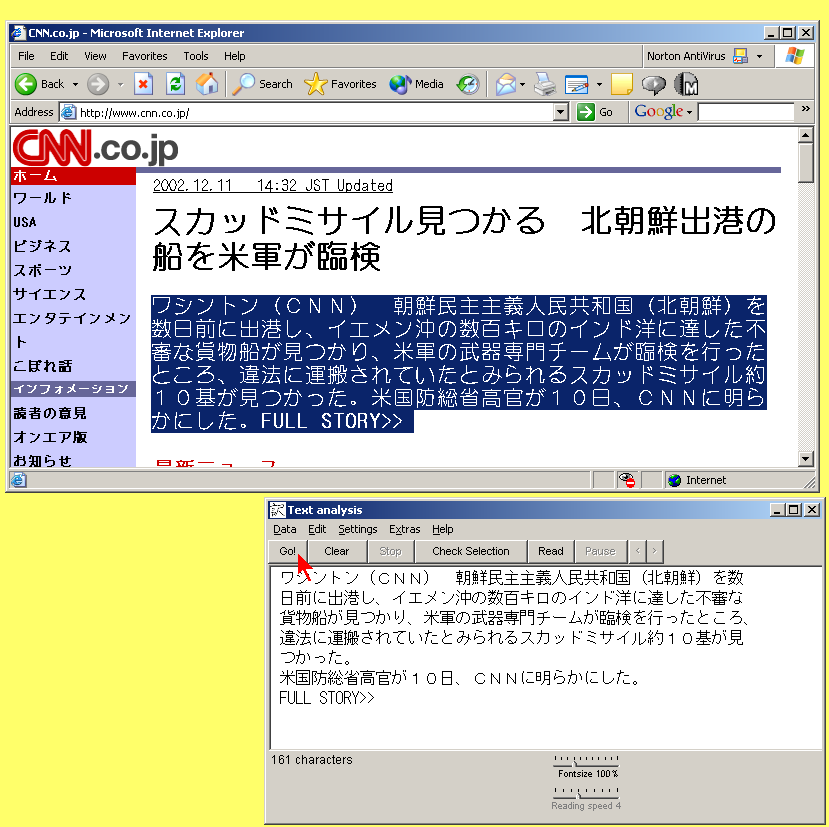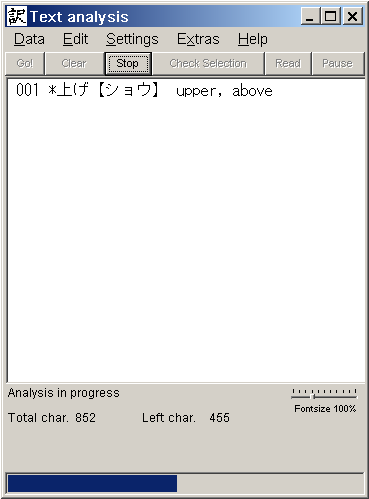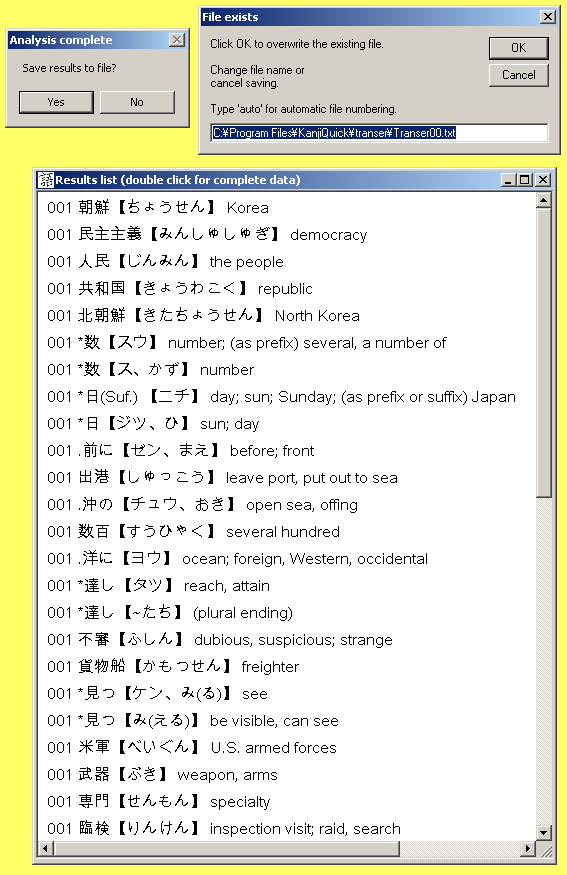| KanjiQuick Voice Documentation |
| [ Home Page | Downloads | Registration ] |
|
[ Contents ] Analyzing and Saving Japanese TextInput of text for AnalysisPlease note that KanjiQuick will search the database for complete matches with the selected string. Thus, if the string contains any kana characters following the kanji or compound, KanjiQuick search may fail. Using this method requires you to have some lexical knowledge of Japanese in order to recognize and correctly set the "word borders." In other words, be sure not to include any kana characters in your search. Include only kanji. Copy text from another application and paste it in the Text input box of the Transer Text Analysis module. Copying can also be performed by pressing the Ctrl+C or Shift+Delete keys; pasting by the Ctrl+V or Shift+Insert keys. With some applications like MS Word® and MS Internet Explorer® (see example below), drag and drop is also available.
Choose Data > Load File from the Text Analysis window to load a file from any location. The file loaded must be Unicode-formatted to be accepted for analysis. If you cannot successfully paste text into the Text input box , it is most likely not in Unicode format. First paste the text into Windows Notebook, or Wordpad, or another Microsoft application, and then re-copy the text and paste it into the Text input box . To make changes to the Japanese text, edit it with IME enabled. You may use the Find and Replace function from the Edit menu useful for correcting optical character reader (OCR) text. Also, you can enlarge the font size by moving the fontsize slider below the Text input box to a maximum of 240%. Right click the fontsize slider to restore to 100%.
After inputting data, click the button, or select Data > Start Analysis from the menus, or you may press Ctrl+Y on your keyboard. KanjiQuick will display in the Results List all entries found in the text within the Text input box . At the bottom, the number of total characters in the input box and the number of characters still to be processed is displayed. Saving the Analyzed TextText from the Transer Text input box will not be saved automatically. Pressing Ctrl+S saves the Transer text you are analyzing, or choose Data > Save File from the Transer Text Analysis menu. The initial default filename is Text01.txt. This file will be saved to your ...\KanjiQuick\transer folder. If a file with this name exists, and you click to save again, KanjiQuick will create a new file named Textnn, with nn corresponding to the next available number in serial order, up to 100 files. Controlling the AnalysisYou may click the Windows Quit button to cancel the analysis. A subsequent analysis can be executed after the Text input box has been cleared by clicking on the button of the Text Analysis window and text has been entered in the text input box again. After a short time, depending on your CPU speed, a Results List window will appear listing all kanji strings that match entries in the KanjiQuick database. You can regenerate the Results List by pressing Ctrl+Y, or from the Text Analysis menu Data > Start Analysis . This may be useful after editing the text for any reason. Though text input is limited to 66,000 characters, due to performance considerations the Transer module will only analyze the first 12,000 characters of a text. After analysis, the completed text will be grayed out. To continue with the analysis, delete the gray text, and proceed as described above. Saving the ResultsThe Results List window data can be saved to a file. The initial default filename is Transer00.txt. This file will be saved to your ...\KanjiQuick\transer folder. To save the file, choose in the Analysis Complete message window that appears, or to cancel saving. If you check AutoSave Results from the Settings menu of the Text Analysis window, all results will be saved automatically. If a file with the save name already exists, KanjiQuick will prompt you to change the name or confirm to replace the existing file with the new one. Type "auto" (without the quotes) instead of a file name to automatically number all saved files. You may also press Ctrl+R to auto-number the saved files. The file names created by default will be Transernn, with nn corresponding to the next available number in serial order, up to 100 files (nn = 00 through 99). The file is Unicode-encoded, and can be read by Microsoft Word®. Columns are separated by tabs in order to easily format the text as a table. The auto-numbering, file-save option is valid as long as the Text Analysis window has not been closed. You should consider moving the files created in the ...KanjiQuick\...\transer folder after each translation session to avoid mixing up one document with another. If you choose to rename the Transer folder, be sure to create a new, empty ...\KanjiQuick\transer folder in the same location or else KanjiQuick will be unable to save files.
|
| [ Contents ] |
menu items, sliders | | Text input boxes | | display boxes | | separate windows | ||
|
Copyright © Program coding and design by Kay Genenz on behalf of JaF, Duesseldorf, Germany 2002. |


